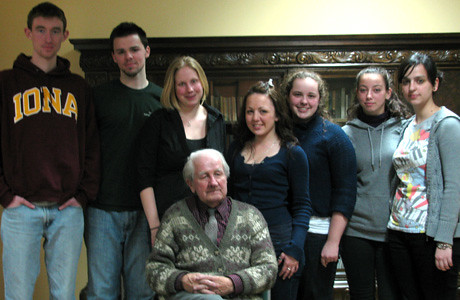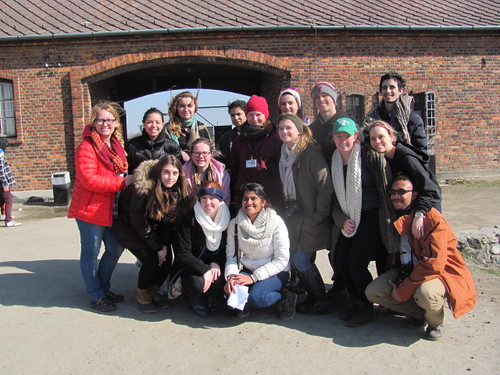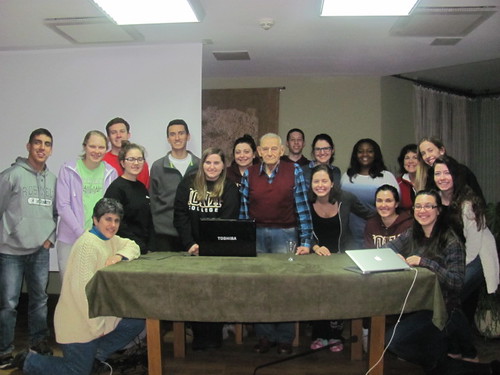Flying home there was a consensus within the class, what do we say when people ask how our trip was? Did we have fun? This was not a trip in which you go home and say “I had fun” like our peers who went on other trips for their spring breaks. This was a learning experience that I think all of us still need to process.
 On Wednesday of our trip we went to the exhibit for Mariana Kołodzieja, he was a Christian Pole who was in Auschwitz One. His experience at the camp was too difficult for him to speak about so he drew. He created these intense and extremely intricate pieces that depicted the prisoners, the SS guards, and demons. For the amount of work he created and how he himself had it displayed we needed more time than we had to really look at all the pieces and view his story. That night when I laid in bed, I closed my eyes and saw the desperate faces he drew. (Seen in the picture to the right)
On Wednesday of our trip we went to the exhibit for Mariana Kołodzieja, he was a Christian Pole who was in Auschwitz One. His experience at the camp was too difficult for him to speak about so he drew. He created these intense and extremely intricate pieces that depicted the prisoners, the SS guards, and demons. For the amount of work he created and how he himself had it displayed we needed more time than we had to really look at all the pieces and view his story. That night when I laid in bed, I closed my eyes and saw the desperate faces he drew. (Seen in the picture to the right)
David Olère, another artist we saw who shared their experience through painting. Olère was a sonderkomando, a prisoner who was forced to work in the crematorium, the one who took the bodies from the gas chamber to the fire. His work was dark and beautiful just as Kołodzieja’s work, although for me maybe a little less haunting. Olère’s work depicted the experiments done on women, the process the sonderkomandos put the corpses, and depictions of the cremation process. One of the painting that stuck out to me most was titled “Freedom begins at the top of a chimney.” The part of the painting I remember was in the chimney smoke of the crematorium there were ghosts or souls of the victims. I think it depicts how horrible the conditions were at the camps and how many would be murdered every day.
In class our professor quoted Michael Berenbaum when he referred to reflecting on the holocaust is to think of the absence of presence and the presence of absence. This quote relates to the work of Mariana Kołodzieja and David Olère because the presence of their work is a presence of absence, highlighting the 6million souls lost in the camps. I personally felt the absence of presence walking through Birkenau. Walking through the children’s barracks, block 16, there was a mural when you first walk through the door. The Museum doesn’t know who exactly created these but know it was most likely another prisoner who wanted to give the children a more permanent gift.
Before this trip I knew I would learn about suffering and the effects of hate. I did not expect to see amazing works of art that fought against the hate. I still do not know what I will tell family and friends when they ask if I had fun but I know I can say I learned more dimensions than I thought I would and overall had a great trip through Poland.
 On Wednesday of our trip we went to the exhibit for Mariana Kołodzieja, he was a Christian Pole who was in Auschwitz One. His experience at the camp was too difficult for him to speak about so he drew. He created these intense and extremely intricate pieces that depicted the prisoners, the SS guards, and demons. For the amount of work he created and how he himself had it displayed we needed more time than we had to really look at all the pieces and view his story. That night when I laid in bed, I closed my eyes and saw the desperate faces he drew. (Seen in the picture to the right)
On Wednesday of our trip we went to the exhibit for Mariana Kołodzieja, he was a Christian Pole who was in Auschwitz One. His experience at the camp was too difficult for him to speak about so he drew. He created these intense and extremely intricate pieces that depicted the prisoners, the SS guards, and demons. For the amount of work he created and how he himself had it displayed we needed more time than we had to really look at all the pieces and view his story. That night when I laid in bed, I closed my eyes and saw the desperate faces he drew. (Seen in the picture to the right)
David Olère, another artist we saw who shared their experience through painting. Olère was a sonderkomando, a prisoner who was forced to work in the crematorium, the one who took the bodies from the gas chamber to the fire. His work was dark and beautiful just as Kołodzieja’s work, although for me maybe a little less haunting. Olère’s work depicted the experiments done on women, the process the sonderkomandos put the corpses, and depictions of the cremation process. One of the painting that stuck out to me most was titled “Freedom begins at the top of a chimney.” The part of the painting I remember was in the chimney smoke of the crematorium there were ghosts or souls of the victims. I think it depicts how horrible the conditions were at the camps and how many would be murdered every day.
 |
| The sign for David Olere’s exhibit at Auschwitz 1 |
In class our professor quoted Michael Berenbaum when he referred to reflecting on the holocaust is to think of the absence of presence and the presence of absence. This quote relates to the work of Mariana Kołodzieja and David Olère because the presence of their work is a presence of absence, highlighting the 6million souls lost in the camps. I personally felt the absence of presence walking through Birkenau. Walking through the children’s barracks, block 16, there was a mural when you first walk through the door. The Museum doesn’t know who exactly created these but know it was most likely another prisoner who wanted to give the children a more permanent gift.
Before this trip I knew I would learn about suffering and the effects of hate. I did not expect to see amazing works of art that fought against the hate. I still do not know what I will tell family and friends when they ask if I had fun but I know I can say I learned more dimensions than I thought I would and overall had a great trip through Poland.




















